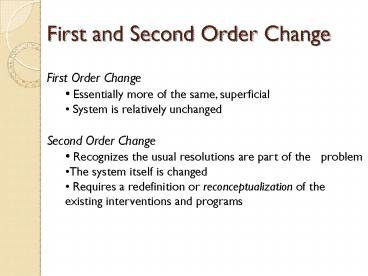First and Second Order Change - PowerPoint PPT Presentation
Title:
First and Second Order Change
Description:
First and Second Order Change First Order Change Essentially more of the same, superficial System is relatively unchanged Second Order Change Recognizes the usual ... – PowerPoint PPT presentation
Number of Views:122
Avg rating:3.0/5.0
Title: First and Second Order Change
1
First and Second Order Change
- First Order Change
- Essentially more of the same, superficial
- System is relatively unchanged
- Second Order Change
- Recognizes the usual resolutions are part of the
problem - The system itself is changed
- Requires a redefinition or reconceptualization
of the existing interventions and programs
2
Social Change
Social change is second order change - It
restructures the basic ways in which people in a
society relate to each other with regard to
family economics, government, education,
religion, life, recreation, language and other
basic human interaction activities. Social
change requires new ways of thinking and
interacting, and challenges our predilection to
solve problems with the same old rules and
steps. Social change is not changes in
demographics or planned efforts to increase
oppression.
3
Factors Promoting Social Change
- Creative thinking and challenges to
- assumptive worlds
- Mindscapes that favor social equality
- Willingness to undergo disruptive change
- Investment in changing reward structures
- Conscientization
- Common cause with others
- Strong value base
4
Conflict vs. Cooperation
- Community organizing seen as conflict-based
- Power-based
- Coalition building seen as cooperation-based
- Relationship based
- Bring diverse groups together to create change
- Can be contentious
- Builds a sense of common cause
5
Community Organizing
6
Coalition Building
7
Coalition Building Favored
Change agents have a growing awareness that
community problems are interrelated and so
require holistic, community-wide solutions It is
increasingly difficult to clearly identify
enemies in our technological and transnational
society Our survival depends on creating common
cause Bernice Johnson Reagon
8
Alternative Settings
Any instance in which two or more people come
together in new relationships over a sustained
period of time in order to achieve certain
goals.
Sarason (1972)
- Characteristics -
- Radical, proposing new/untried ways of
addressing social problems - Radical structure, goals, ideologies
- Alternative not synonymous with progressive
- Creation -
- Shaped long before inception
- Form out of dissatisfaction with existing
settings and optimism about having a positive
effect - Departure of founding members
- Many do not survive the first year
9
Alternative Settings
- Healthcare
- CVS
- In-home
- In schools
- Education
- Charter schools
- Learning Centers
- Metropolitan Learning Alliance
- Communities
- Celebration, FL
10
Alternative Setting Challenges
- How to become established while remaining
radical - Seeking funding may jeopardize the goals/mission
- Collaboration with other agencies correlates
with legitimacy and longevity - Organization structure for sustainability
- Remain flexible, true to the mission
- Clear goals
- Meaningful identity
- Participatory decision making
- Oppose the status quo
- View setting as transitory
- Establish opportunities for reflection and
criticism































